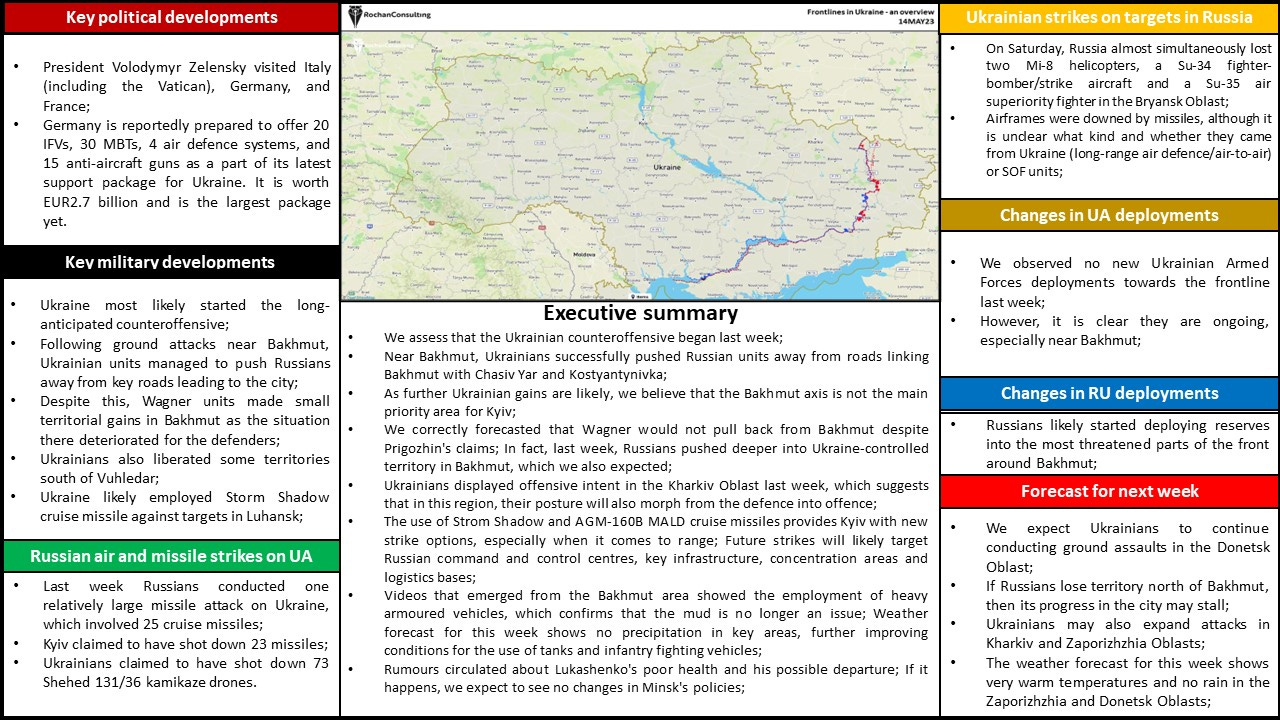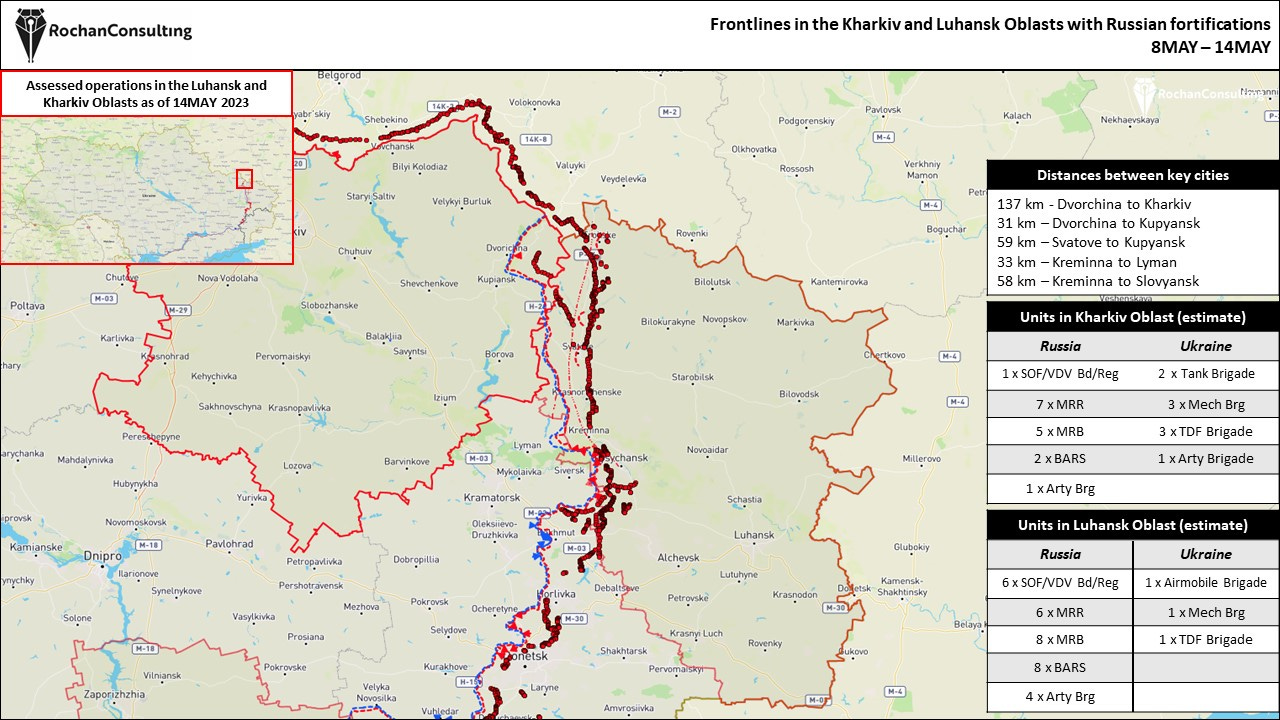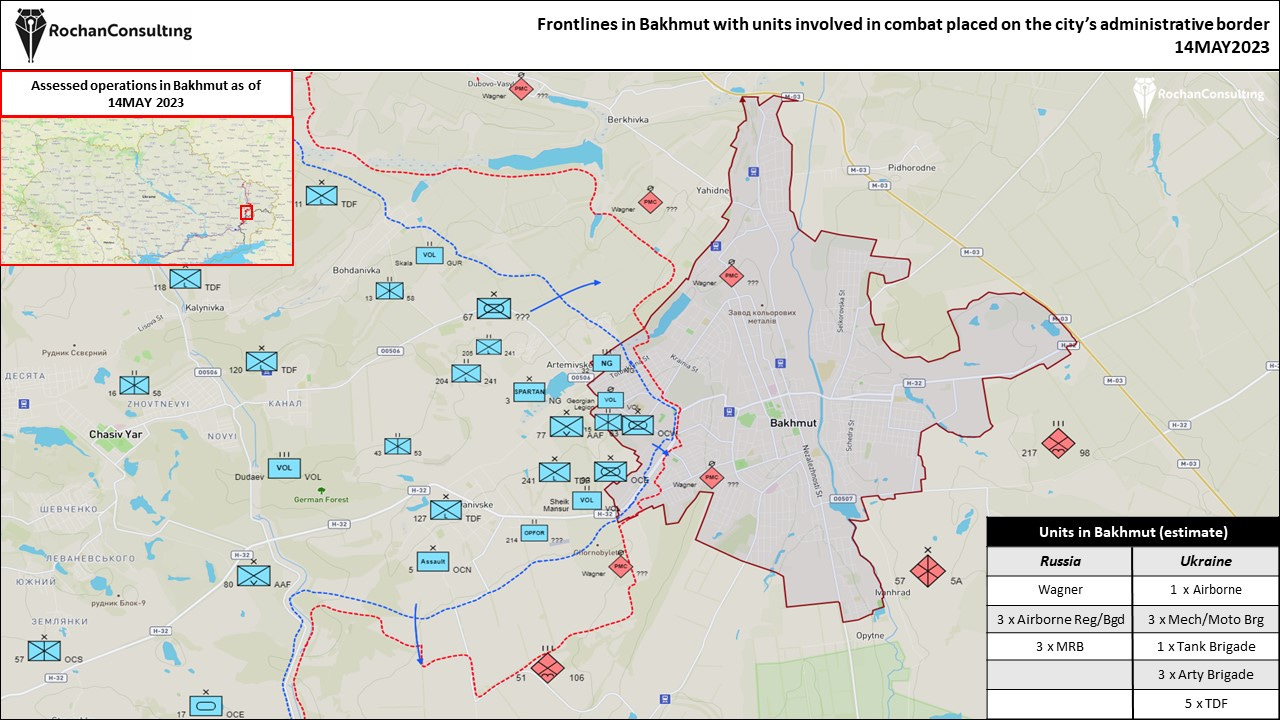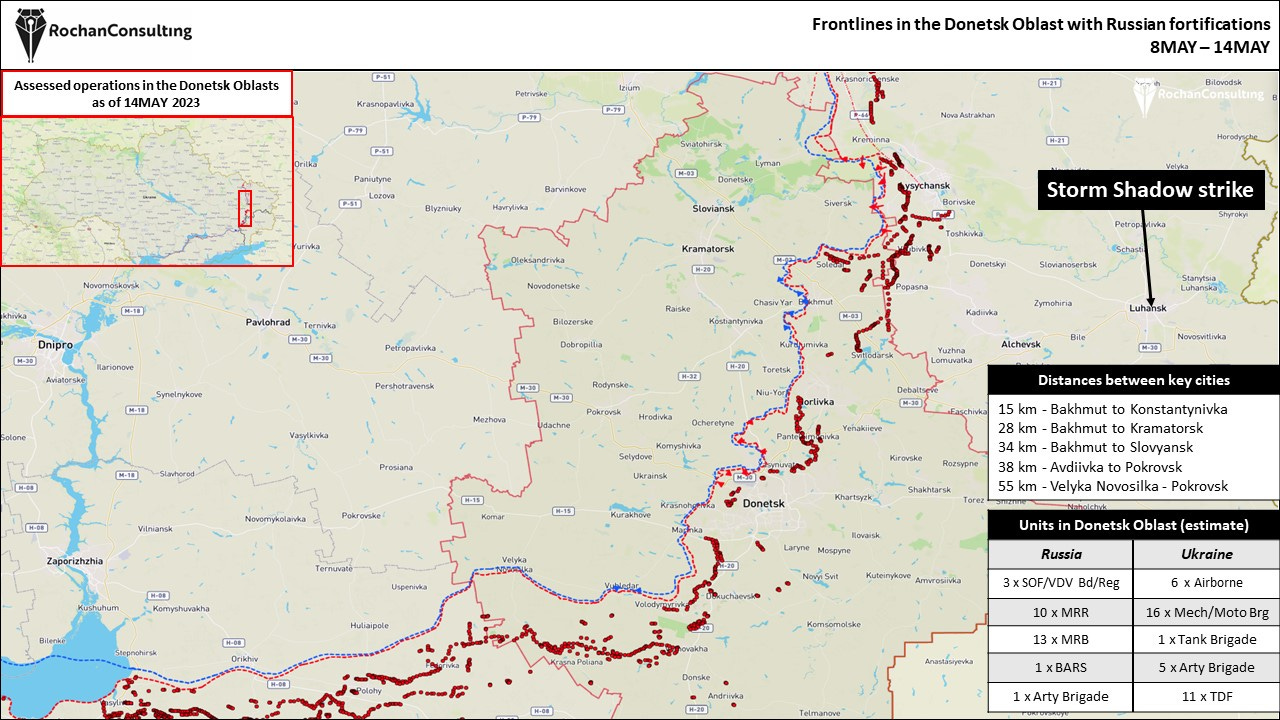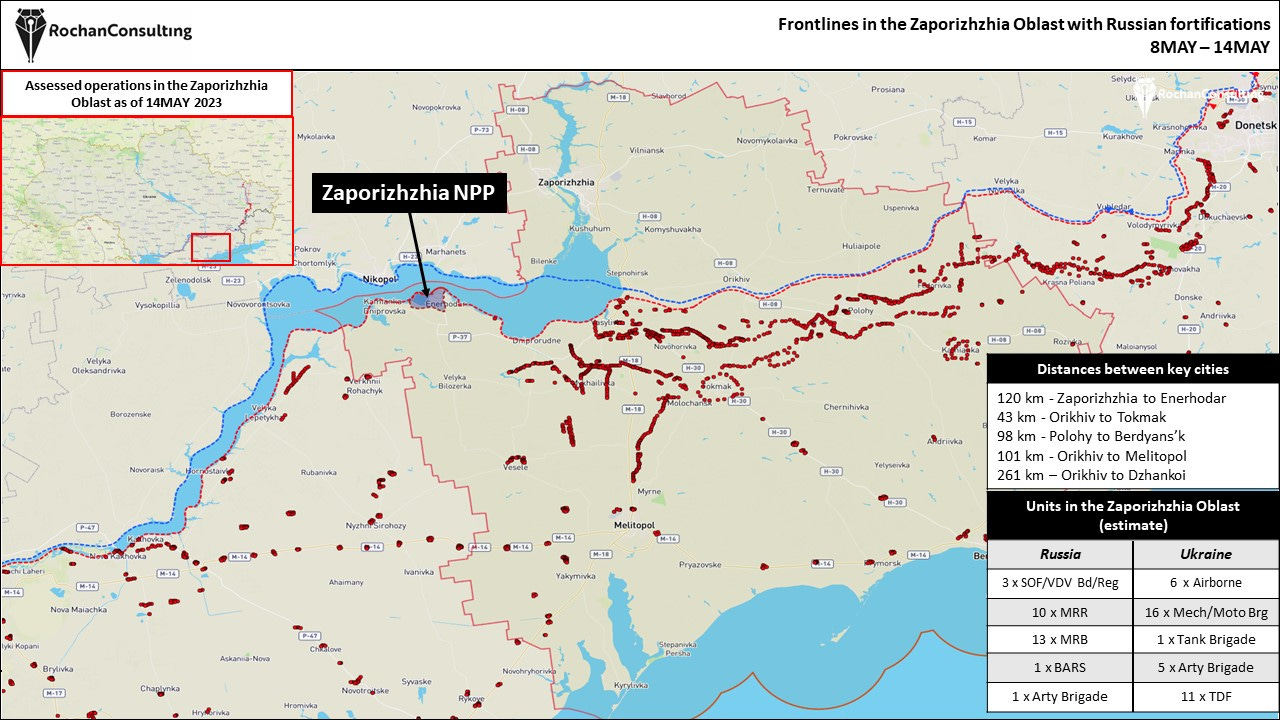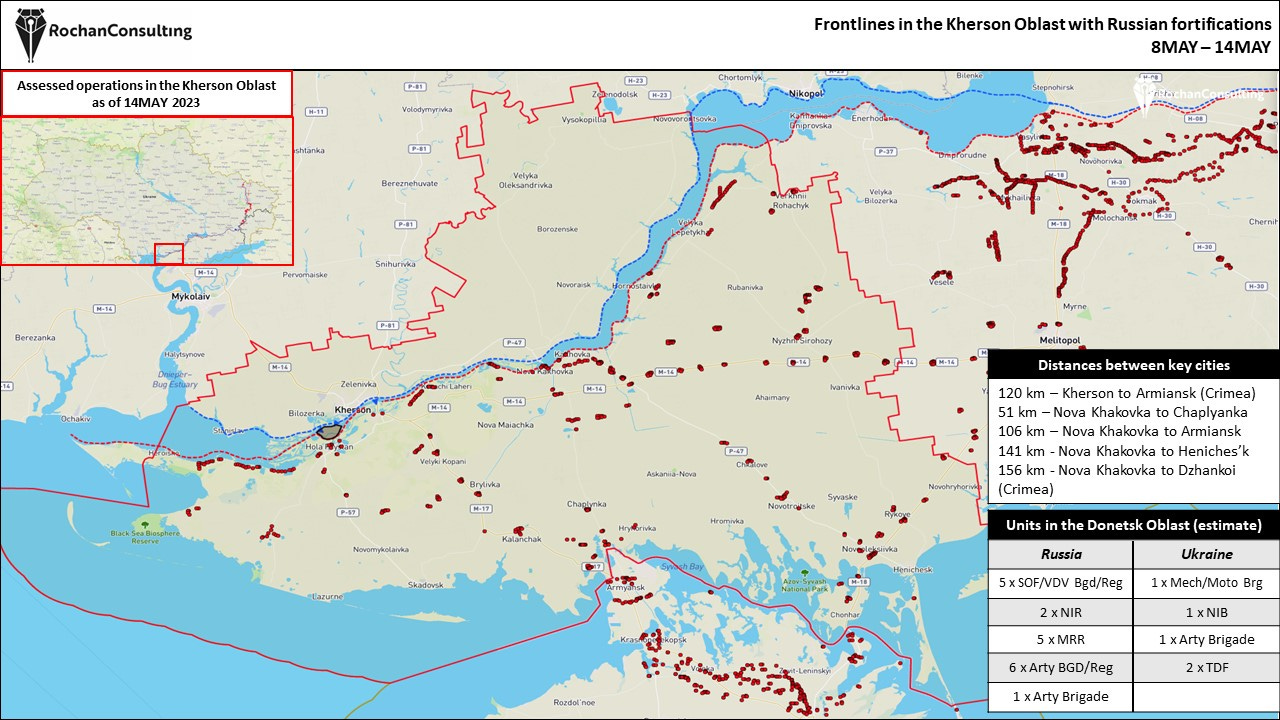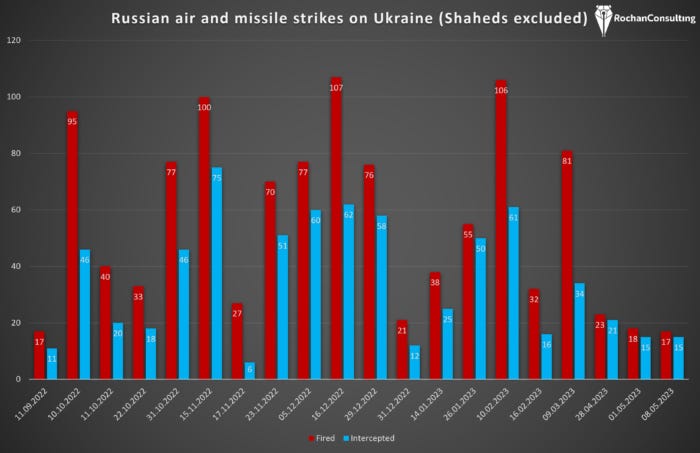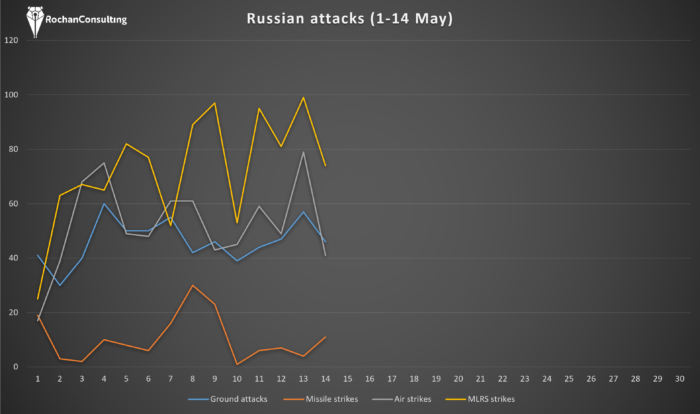Ukraine Conflict Monitor - 8 May – 14 May (Weekly update)
BLUF: Last week delivered significant changes on the battlefields in Ukraine. Kyiv’s posture transitioned to the offence near Bakhmut, where Ukrainians managed to liberate areas southwest and northwest of the city. Ukrainians also made some territorial gains near Vuhledar. The addition of long-range cruise missiles allows Kyib to strike critical Russian targets in depth. We assess that the Ukrainian counteroffensive has begun.
Key takeaways from last week’s developments:
With successful Ukrainian counterattacks near Bahkmut and elsewhere in the Donetsk Oblast, Kyiv likelY started its long-awaited counteroffensive;
We continued to see no major changes in the Kharkiv Oblast; Russians continued limited ground attacks and heavy artillery strikes; We may see early indications of changes in Ukrainian posture as Kyiv’s forces also launched an attack in the region;
Russians made no territorial gains last week in the Luhansk Oblast as all attacks were repelled; The attackers also did not capture new territory near Bilohorivka, which they were mainly focused on two weeks ago; The apparent employment of UK-supplied Storm Shadow cruise missile in Luhansk opens up new strike options for Ukrainians to degrade Russian ability to C2 and supply its forces;
Ukrainians conducted successful counterattacks on both flanks near Bakhmut and managed to push Russians out by at least two kilometres in the north and south; Wagner units, however, progressed in Bakhmut;
Russians made no confirmed gains in other parts of the Donetsk Oblast, while Ukrainians pushed Russians further south near Vuhledar;
No frontline changes occurred in the Zaporizhzhia Oblast; Russians reportedly continued to evacuate civilians from the region among fears of impending Ukrainian counterattack;
Ukrainians may have made some gains on an island on a Dnipro delta; In the region, too, Russian authorities organised evacuations;
The posture of the Belarusian Armed Forces remained unchanged. The sudden disappearance of Lukashenko is not yet a sign of concern;
Last week Russians fired at least 28 cruise missiles on targets across Ukraine, of which 26 were reportedly intercepted; Kyiv claimed to have also shot down 73 kamikaze drones;
Executive summary
Based on all Ukrainian ground activity last week, we believe the Ukrainian counteroffensive commenced, and the war transitioned to the offensive phase. Although Kyiv made relatively significant gains near Bakhmut, we do not consider this area the main Ukrainian focus point. As stated previously, the counteroffensive will probably have one main axis of advance and a few auxiliary axes. Bakhmut falls into the latter category. However, Ukrainian gains should not be dismissed. Not only did Kyiv relieve pressure on the key road linking Bakhmut with Chasiv Yar, but its attacks exposed fundamental Russian weaknesses: a lack of coordination between regular Russian formations and Wagner units, poor communication and morale, all of which led to more or less disorganised withdrawals. It is also particularly noteworthy that Ukrainian gains were achieved without using major Western-supplied platforms, such as Bradley IFV or Leopard tanks. It, therefore, seems that Russian defensive lines are easily penetrable, at least near Bakhmut. Although we are speculating now, these limitations can severely impact Russian ability to defend and create conditions for further disorganised withdrawals.
The situation in the city deteriorated for Ukrainians last week. Still, if Kyiv continues advancing north and south of the town, then Wagner’s tempo of attacks in Bakhmut will probably decrease. This week will show how the Russian leadership will react to the recent Ukrainian gains.
Speaking of Bakhmut, as expected, Wagner did not pull out from the city. As early as Monday, Wagner said all supply issues were ironed out. However, by mid-week, Prigozhin again lashed out at Gerasimov (Russian Chief of General Staff) and Shiogu (Russian Minister of Defence) for unfulfilled promises, the poor state of Russian regular army formations, which led to a hasty withdrawal near Ivanivske. Although the conflict between the two camps continues to grow, we do not expect to see a Wagner withdrawal from the city because of this feud. Unless there is a collapse of Russian lines around Bakhmut, Wagner will highly likely stay and fight there.
Although Ukrainians conducted no major UAV attacks on Russian bases and facilities in Crimea last week, on Thursday, they employed what appeared to be the UK-supplied Storm Shadow stealth cruise missile. A successful attack on a Russian base also coincided with the use of an AGM-160B MALD decoy missile that can mimic radar signatures of various aircraft. This duo not only provides Kyiv with increased chances of conducting a successful missile strike but also, with a reported range of over 250 km, the Storm Shadow can degrade Russian ability to command and supply their forces. Attacks on Luhansk confirmed that the system had been integrated into Ukrainian launching platforms. But bottlenecks could persist. For one, we do not know how many missiles had been sent to Ukraine, and poor missile availability could limit Storm Shadow’s use. But the bear threat of its use should also force Russians to disperse their logistics bases and command posts to avoid their destruction, akin to when the first HIMARS platforms entered service. This in itself should have a negative impact on Russian logistics.
The frontline remained unchanged in Kharkiv and Luhansk regions. On Sunday night, a Russian source claimed that Ukrainians made slight gains in the Svatove area, or in other words, Russians withdrew, allowing Ukrainians to capture a destroyed village. We, however, have not been able to verify this claim. Ukrainians also conducted limited attacks in the Kharkiv Oblast, which could also herald changes in their posture in this part of the front. No changes were reported in the south, where the frontline was stable in the Kherson and Zaporizhiahia Oblast.
Nevertheless, Russians continued to extract and evacuate their personnel from the most threatened parts of both regions. Russian-instilled administration bodies are also reportedly being evacuated. These developments confirm a lack of trust in the Russian Armed Forces’ ability to repel the Ukrainian counteroffensive and, thus, the viability of Russian control over occupied territories.
Apart from the Bakhmut area, Ukrainians pushed Russians further south in the Vuhledar area. Russians there are also on the defensive.
We continued to see no changes in the posture of the Belarusian Armed Forces. During the weekend, the Belarusian MoD announced that the 336th Rocket Artillery Brigade and the 465th Missile Brigade were deployed in “Combat Status” to the country’s western borders. The deployment came when rumours started circulating about Belarus’ President, Alexander Lukashenko, poor health. It is too early to discuss what can happen if he departs. However, we can make some general observations. Firstly, as per the Belarusian constitution, if the president is unfit for service, he is succeeded by the Speaker of the Council of the Republic of Belarus, Natalya Kochanova. She was Chief of Staff for Lukashenko’s election campaign in August 2020. She is also under sanctions by the EU, the United Kingdom, the United States, and Switzerland for her role in squashing the protests, so she a part of the regime. Secondly, protests that broke out in Belarus after the elections were against Lukashenko and not against Russia or for the EU or NATO. As such, Lukashenko’s departure would fulfil Belarusian citizens’ demands from 2020, so the likelihood of another wave of protests is small. Lastly, it is improbable that a successor would come from outside of the regime. Belarus is an intelligence-driven state with the KDB (or KGB) playing a crucial role in maintaining regime stability. Given its close links with Russia, it is improbable that a successor would not be “approved” by security services and, by extension, by Moscow.
Looking into this week, we expect Ukrainians to continue attacking near Bakhmut and making steady gains. It is also possible that they will step up their ground attacks in other parts of the Donetsk Oblast and will further utilise long-range, high-precision cruise missiles to hinder Russian responses to Ukrainian attacks. We see no evidence to suggest that a new axis of attack will be opened in the Zaporizhihia Oblast.
The weather forecast will support the employment of heavy, armoured vehicles. This week is forecasted with very warm temperatures (above 20°C (68°F)) across the country and no rain. Available imagery also shows that Ukrainians effectively utilised APCs and MBTs near Bakhmut, and based on these videos, it appeared that the ground was dry. We expect mud will no longer be a problem by the end of May.
Before discussing the situation in selected parts of Ukraine, here is the link to our Scribble Map. It contains a lot of helpful information that you can use to make your assessments. The link to the map is regularly changed, so please make sure you access the map by clicking on the link from the latest UCM issue.
The situation at selected axes and directions
Kharkiv direction
No significant changes were reported in the Kharkiv Oblast last week. No Russian cross-border ground attacks were reported. However, Ukrainians’ posture may be in transition as last week they launched assaults near Vilshana. Indeed, a Russian source stated that Ukrainians might attempt to encircle Russian units in Horobivka, Tavilzhanka and Dvorichna.
We noticed no changes in Russian actions. They continued trying to break Ukrainian lines near Hryanykivka, Masiutivka and Krohmalne. However, all assaults were repelled. They also continued artillery strikes on villages and cities in Kharkivsky, Kupyansky, Iziumsky and Chuhuivsky districts. Ukrainian concentration areas in Kupyansk and Balakliya were reportedly hit with Iskander missiles.
According to the Russian MoD, Ukrainians lost a Su-27 near Izium.
The Russian MoD also regularly informed about the destruction of Ukrainian reconnaissance groups in Kharkiv and Luhansk directions, although it never provided evidence supporting these claims. For instance, two Ukrainian sabotage and reconnaissance groups from the 14th and 92nd Mechanised Brigades were destroyed in the Kupyansk direction. At the same time, rotation attempts were interrupted near Dvorichna, Timkovka and Tabaivka. Russian Ka-52 and Mi-28 attack helicopters also hit the 119th and 127th Territorial Defence Brigade’s (TDB) deployment areas near Krasny Khutor, Veselivka and Ohrimivka (we could not find these locations). Russian aircraft also struck the positions of the 14th Mechanised Brigade in Ivanivka and the 103rd TDB in Kotlyarivka.
We continue to expect no changes in this region in the short term (until the end of May). No reports suggest that either side was preparing its forces for more organised and large-scale attacks.
Luhansk direction
No frontline changes were reported in the Luhansk Oblast last week. Most positional battles continued along the Ploshchanka – Bilohorivka line but did not impact the frontline.
According to Serhiy Cherevaty, the Eastern Group of the Ukrainian Armed Forces spokesman, on 8MAY, in the Lyman direction, Russians struck Ukrainian positions 444 times. This number increased to 555 on 9MAY. Within these two days, they also conducted 25 air attacks and ten ground attacks but lost 114 personnel killed and 207 wounded. Unfortunately, Cherevaty does not provide such figures daily, so it is difficult to see trends in Russian actions, at least as reported by the Ukrainian military bodies. Nevertheless, it seems that the Kreminna area continued to be the heaviest-shelled part of Ukraine.
The situation in the Svatove area remained stable. Late in the week, Russian attacks were recorded near Stelmakhivka, but they did not alter the frontline.
No changes occurred near Makiivka, Ploshchanka and Chervonopopivka areas. On Tuesday, no Russian attacks were recorded towards Torske, Nevske and Makiivka. Russian attempts to shift the frontline near these settlements likely continued throughout the week, but neither Russian nor Ukrainian sources reported any changes in these sectors.
Positional battles continued near Dibrova and the Serebryansky forest, but no changes near Kreminna were reported. Although Ukrainian bloggers claimed that the most difficult situation remained in the Serebryansky forest, they failed to explain what this meant. We understand that Russians continue to pressure Ukrainian units in the forest, but despite daily attempts to dislodge the defenders, they achieved no success.
Following’s prior week’s attacks near Bilohorivka, Russians did not follow on with a new wave of attacks on the settlement. The frontline in this area remained unchanged.
On Thursday, 11MAY, the UK government confirmed it had supplied the Storm Shadow cruise missile to Ukraine. The next day, two explosions were reported in Luhansk at Machine Factory 100, which Russians used as a logistics and repair depot. More importantly, the city is located more than 80 km from the frontline, beyond the reach of existing Ukrainian precision-strike weapon systems. On Saturday, the Russian press agency, Izvestia, published images of what appeared to be the remnants of the Storm Shadow cruise missile picked up from the strike site. Interestingly, remains of an AGM-160B MALD decoy missile were also found in Luhansk. The strike thus confirms that Kyiv now has the long-range, stealth precision-strike capability (Storm Shadow is credited with a 250-450 km range) and uses it in conjunction with decoys to deceive enemy air defences, thus, increasing the chances of success of the strike.
The AGM-160B MALD has a range of 500 nautical miles (926 kilometres) and mimics radar signatures of different aircraft types. The -J variant can also jam opposing forces’ radars, but whether Ukraine has obtained this capability is unclear. Nevertheless, the MALD-Storm Shadow duo opens up new striking options for Kyiv, allowing it to successfully target command and control centres, key infrastructure, concentration areas and logistics bases.
On Saturday, the Luhansk Academy of Internal Affairs building was struck too, presumably again by Storm Shadow. It is unclear how many people were killed and wounded in these strikes, but Russian State Duma member Viktor Vodolatsky was reportedly injured in the first strike.
(We give medium confidence to the number of combat units displayed on our maps. A brigade/regiment deployed near the frontline does not mean the unit is at full strength. In fact, many Russian formations deploy only one or two battalions. The data on Russian fortifications comes from Brady Africk).
Donetsk Oblast Direction
The tide seemed to change last week in the Donetsk Oblast. Although Wagner forces continued to make incremental gains in Bakhmut, Russians lost ground on the flanks. Ukrainians began to exert bigger pressure on Russian positions in other parts of the region. Without significant reinforcements, it seems unlikely that Russians will be able to halt the Ukrainian forward movement.
But let’s start with the northern parts of the oblast. The tactical and operational situation did not change in this area. On Friday, the Russian MoD published footage showing a Ukrainian stronghold captured near Spirne. Although Ukrainian sources did not report any changes in this area, we assess that this Russian territorial gain does not impact the overall tactical-operational situation in this part of the Donetsk Oblast.
No changes occurred near Vekhnokamyanske and Vyimka.
Ukrainian sources claimed that Russians lost some ground near Bilohorivka. This development was confirmed by the Russian MoD, which explained that the withdrawal of the 9th Motor Rifle Regiment near the settlement was to improve the stability of the defence.
The frontline remained stable in Vasiukivka, Fedorivka, Rozdolivka, and Vesele.
Now entering the Bakhmut axis, Ukrainians conducted limited but successful counterattacks northwest of Khromove and relieved the Russian pressure on the T0506 road linking Bakhmut with Chasiv Yar. The road is no longer under small arms fire as Russians were pushed more than two kilometres (more than a mile) northeast.
The situation on the northern flank does not look good for Russians. Wagner and Russian operational (regular) army formations must cooperate to defend the area effectively. But, it is clear that interoperability levels among Russian units involved in combat in this sector are minimal at best, to the extent that both armies (MoD and Wagner) fight their own wars, both with Ukrainians and among themselves. Consequently, if Ukrainians keep pushing in this direction, we may see more disorganised withdrawals and a speedy reversal of Russian gains they achieved over a brutal several-month-long ground campaign.
Last week, CNN published a short video showing battles near Bakhmut. The video is interesting for several reasons. Firstly, a Ukrainian commander claimed that Wagner units were the first to abandon their positions. Secondly, he said that HIMARS-fired missiles were used to strike Russian tactical reserve, meaning the system supports tactical engagements. Lastly, it does not seem the Ukrainian attack was sizable, yet Russian units folded. Neither did Ukrainians employ major Western-supplied platforms, such as MBTs or IFVs. Thus, Russian defensive positions appear fragile and susceptible to fast-paced manoeuvre.
All of this combined, if the Russian posture is not adjusted, then the possibility of a rout is real.
It also seems that the weather is enabling the deployment of heavy armour. A video posted by Ukrainians fighting near Bohdanivka shows a tank engaging Russian positions. Multiple similar videos emerged last week, meaning the ground is sufficiently dry to support combined-arms manoeuvre.
Despite gains made northwest of Bakhmut, Kyiv’s situation in Bakhmut deteriorated. Wagner continued storming attacks on the northern, southern, and eastern flanks. Battles in the city occurred near the Medical College and the Olympic Reserve School, but the line of contact lies along Vyzvolyteli Donbasu – Chaikovskoho – Robocha Streets.
Wagner also approached Marshal Tolbukhin and Iryna Levchenko streets. Throughout the whole week, Wagner advanced around 500 meters westwards. Prihozhyn stated that if Wagner pushed another 600 m, his forces would reach the western entrance to Bakhmut. However, we assess that Wagner positions are around 1 km from this point.
Early in the week, Prihozhyn again complained that his forces did not receive promised ammunition, saying that only ten per cent of the requested supply was delivered.
Similar to the northern flank, Russian positions south of Bakhmut also crumbled as Ukrainians pushed the attackers from Stupochky and Ivanivske. Anna Malyar, Ukrainian deputy defence minister, said that Ukrainian units advanced by 2 km in this area.
Wagner owner, Yevgeny Prigozhin, accused Russian formations of breaking the line and withdrawing disorderly. He especially lashed out at the 72nd Motor Rifle Brigade of the 3rd Army Corps, which reportedly abandoned their positions, exposing Wagner’s flanks.
The 3rd Assault Brigade also captured Russian positions west of Klishchiyivka as Russians were pushed back over the canal. One of the commanders of the 3rd Brigade of UAF stated that the Russians had been pushed back over a 3 km wide and 2.6 km deep area, and this territory had been liberated. He also claimed that the 6th and 8th companies of the 72nd Brigade of the Russian Armed Forces were destroyed, and the third assault unit of the Wagner PMC suffered heavy losses. Klishchiyivka is now reportedly within sight, and its capture may derail Russian attacks on Bakhmut from the southwest.
Wagner and regular Russian army units launched several counterattacks to stall Ukrainian advances, but we understand that they did not recapture any territory.
Some Russian commentators claimed that Ukrainian counterattacks merely sought to relieve the pressure on ground lines of communications to allow Ukrainian units to withdraw from Bakhmut. We find such a course of action to be unlikely. Ukrainian command attacked overextended Russian units, suffering from severe C4 issues. The scale of Russian withdrawal also encourages Ukrainians to continue pursuing their tactical objectives.
On Sunday, the Russian MoD announced the death of two Colonels near Bakhmut, including the 4th Motor Rifle Brigade Commander, Colonel Vyacheslav Makarov, and the Army Corps’s Deputy Commander for Military-Political Work, Colonel Yevgeny Brovko.
According to Cherevaty, Russians use about 25,000 shells per day in the Lyman and Bakhmut directions, meaning there is no shell hunger on their side.
Moving south from Bakhmut, no frontline changes were reported near Niu York, although Russian attacks in this sector only occurred early in the week. Ukrainians also appeared inactive.
Neither Russian nor Ukrainian sources reported any frontline changes near Novobakhmutivka, Krasnohorivka, Novokalynove, Keramik, Berdychi and Stepove. It does not mean that the frontline was peaceful. On Monday, Russians attempted to extend territorial control near Krasnohorivka – Novobakhmutivka, but attacks were ultimately pushed back. Responding to these reports, Ukrainian bloggers claimed that the attackers decreased ground attacks but increased artillery strikes.
According to the Ukrainian source, near Kruta Balka, Russians captured a small piece of land.
Russian attacks on Avdiivka were also somehow subdued. Only early in the week did Russian sources report on ground attacks towards the city, which were unsuccessful anyway.
All Russian attacks near Pervomaiske were unsuccessful. The same goes for Mariinka, where deeply entrenched Ukrainian forces continue to hold their positions in the city’s western parts.
According to a Ukrainian source, Ukrainian troops managed to push Russian troops back across the Kashlagach River near Pavlivka as the Russian 40th Naval Infantry Brigade withdrew from their positions (the unit previously replaced the badly battered 155th Naval Infantry Brigade). The same source claimed that Ukrainian troops conducted a successful counterattack and managed to advance near Velyka Novosilka (probably here).
Zaporizhzhia direction
Last week proved to be relatively calm in the Zaporizhihia Oblast. Limited Ukrainian ground attacks did not translate into any gains.
Russian forces targeted Ukrainian positions in the Zaporizhzhia region. Geolocated footage published on 7MAY showed Russian forces striking Ukrainian positions near Shcherbaky. Another Russian source posted footage on 7 and 8 MAY that purportedly showed elements of the 127th Motor Rifle Division from the 5th Combined Arms Army (Eastern Military District) striking Ukrainian forces near Charivne. Elements of the 503rd Guards Motor Rifle Regiment of the 19th Motor Rifle Division of the 58th Combined Arms Army (Southern Military District) also struck Ukrainian forces near Orikhiv. We understand, however, that these attacks had no impact on the frontline.
At the same time, Russians noted that Ukrainians started to regroup their artillery assets in the region to increase the density of fire. Despite this, Robotyne and Nesteryanka were still very heavily shelled.
Russians also reportedly continued forced evacuations from the region. Yevgeny Balitsky, the Russian occupation head, claimed on 7MAY that 1,552 people had already relocated from areas included in evacuation orders (see Scribble Map). Russians continue to assert that only evacuations only occur on a voluntary basis. However, Vladimir Rogov, Zaporizhzhia Oblast Russian occupation official, said that occupation authorities continued to adjust and expand settlements included in the partial evacuation order. In some cases, evacuees were sent to Berdyansk and Kyrylivka and recreation centres and hotels near the coast of Ukraine. Some agreed to be taken to the Rostov region in Russia and placed in tent camps.
On 8MAY, Balitsky stated that about 3,000 civilians had been resettled to “safe areas”, including 1,000 minors, 300 patients of neuropsychiatric centres, and an unspecified number of children from orphanages from areas along the frontline.
The evacuation order applies to family members of Zaporizhzhia NPP employees. However, those employed at the plant are not allowed to leave the city, according to Russian sources. On the other hand, Ukrainian Energoatom, a state enterprise operating all four nuclear power plants in Ukraine, claimed on 10MAY that 2,700 workers who signed contracts with Rosatom or other “fake companies” sending personnel to the Zaporizhzhia NPP would be evacuated as well. Energoatom expressed concern about a lack of qualified personnel managing the plant, which may endanger its functioning.
Kherson direction and Crimea
Ukrainians reportedly achieved some territorial gains in the Velyky Potemkinsky Island last week. Following the previous week’s attacks on Crimea, Ukrainians did not follow this up with a new round of strikes. In this context, the security situation in the peninsula did not deteriorate.
On 9MAY, a Ukrainian source stated that Ukrainians pushed deeper into the Velyky Potemkinsky Island, partly confirmed by Russian artillery strikes on alleged Ukrainian positions. Two days later, a Russian source asserted that battles for the island continued and that Ukrainians were actively pressing defending Russian units. The source claimed that in case of success, the Ukrainian army would reach the old Dnipro riverbed near Hola Prystan and Kardashinka.
Despite this, we decided not to mark this area as under Ukrainian control as too little evidence exists to support the change.
Last week, the Ukrainian General Staff reported that Russians loaded documentation, office equipment and other property of state institutions and left Skadovsk. On the morning of 7MAY, a significant part of the Russian occupation administration left the city with their families. Similar evacuations were reportedly observed in Mykhailivka, Petrivka, Shevchenka, Shyroke, Ulyanivka and Krasne.
Russians also continued to take steps to prepare for the Ukrainian counterattack. According to Serhiy Khlan, advisor to the Kherson region administration advisor, Russian forces “massively mined” the left bank of the Dnipro River in Kherson Oblast. At the same time, Vladimir Saldo, the Kherson Oblast occupation head, stated that Russian fortifications were well-equipped and that the forces stationed near the Dnipro bank would receive additional anti-drone guns.
Russians also continued striking Ukrainian positions across the entire Dnipro bank. Last week’s focus was on Kherson and Beryslav districts. Kizomys was also reportedly hit with guided bombs.
Russias claimed to have shot down a Ukrainian Su-25 near Bilozerka and Chervonyi Mayak.
Based on Ukrainian Operational Command South reports, Russians fired 521 shells on Ukrainian targets in the Kherson Oblast last week. However, the amplitude of such strikes was very high, from 43 shells fired on Sunday, 7MAY, to more than 300 on Monday. The number of strikes subsequently decreased throughout the week.
It could be a far-reaching conclusion, but based on this data, Russian artillery stocks are replenished over a weekend, which allows them to increase the artillery strike intensity early in the following week. However, the deliveries aren’t sufficient enough to sustain this tempo throughout the week.
Summary of losses
According to the Russian Ministry of Defence, since the start of the war, Ukraine has lost 425 aircraft (+7), 231 helicopters (+1), 4,135 UAVs (+108), 421 anti-aircraft missile systems (launchers?)(0), 9,159 tanks and other armoured combat vehicles (+145), 1,100 MLRS launchers (+4), 4,813 field artillery guns and mortars (+59), as well as 10,193 units of special military vehicles (+156).
According to the Ukrainian General Staff, Russia lost (eliminated) 198,880 personnel (+4,450), 3,756 tanks (+33), 7,325 armoured combat vehicles (+77), 3,116 artillery systems (+106) and 562 MLR systems (+12), 314 anti-aircraft systems (+8), 308 aircraft (0) and 294 helicopters (0), and 2,696 UAVs (+124), 6,018 vehicles and fuel tanks (+66), 970 cruise missiles (+38), 18 warships and boats (0) and 404 special vehicles (+24).
(Numbers in parentheses denote a weekly change)
Russian air and missile strikes on Ukraine
Last week Russians conducted limited missile strikes on Ukraine. On 8/9MAY they fired 8 Kalibr and 17 Kh-101/Kh-555 cruise missiles. The Ukrainian Air Force Command claims to have shot down all Kalibrs and 15 Kh-101/Kh-555s. On 14MAY, Ukrainians also intercepted three Kh-101/Kh-555/Kh-55 cruise missiles, although how many were fired is unclear.
Kyiv also claimed to have intercepted 73 Iranian-made Shahed 136/131 kamikaze drones.
Military situation in Belarus
BLUF: No changes in the posture of the Belarusian Armed Forces were observed last week. Minsk deployed elements of its missile forces near the border with Poland, most likely as a response to the ongoing Polish Anakonda-2023 exercise. Rumours circulated about Lukashenko’s health. We expect no major changes in Belarusian policies if the departs.
No changes in the posture of the Belarusian Armed Forces were observed, although, from the political point of view, several noteworthy events occurred.
The main event pertained to Belarusian President’s visit to Russia to celebrate to participate in the Russian Victory Day Parade. During the actual ceremony that took place on Tuesday, Lukashenko looked visibly unwell. Shortly after the event, the Belarusian leader laid flowers at the Russian Tomb of the Unknown Soldier and returned to Belarus, where he participated in the analogical ceremony on Victory Square in Minsk. Notably, probably for the first time since he came to power in 1994, Lukashenko did not make a speech during the event. Instead, Belarusian Minister of Defence, Lt. Gen. Viktor Khrenin, delivered a statement. Since then, Lukashenko did not appear in public. As the Belarusian Hajun project noted on Saturday, Alexander Lukashenko probably arrived at the Republican Clinical Medical Center in Drozdy. The presidential column left the facility after about two hours. However, it is unclear if Lukashenko was inside. Rumours continue to circulate about his state. Some are quite extreme and say he suffered a heart attack and was in a coma.
Despite the president’s absence, Belarus officially completed the ratification process of the military-technical cooperation program with Russia on Friday. It refers to Law No. 266-3, published on the Belarusian National Legal Internet Portal. The agreement regulates mutual development, production and deliveries of military equipment until 2025. The document was signed on SEP22 and was recently adopted by the Belarusian House of Representatives (18APR) and Council of the Republic (19APR).
The Belarusian MoD also informed about an attack attempt on the Belarusian service members. The incident occurred on the M5 highway near Yasen village when a heavy vehicle driver tried to attack a Belarusian soldier with homemade explosives. Nevertheless, he failed and was detained shortly after.
Regarding exercises and drills, the Head of the Main Combat Training Directorate, Maj. Gen. Alexander Bas led firing classes for Belarusian MoD, General Staff personnel and centrally subordinated formations on Friday.
On Tuesday, the Belarusian Hajun project provided results of its work on geolocating recent movements of the 336th Reactive Artillery Brigade and 465th Missile Brigade that were undertaken as a part of the readiness drills. Polonez and Tochka-U subunits reached the Ross airfield in the Volkovyvsk region about 40 kilometres from the Polish border. This deployment is likely Minsk’s “answer” to the ongoing Anakonda-2023 exercise of the Polish Armed Forces.
Moreover, the 38th Air Assault Brigade continued the induction of reservists. As the Deputy Commander of the Belarusian Special Operation Forces, Col. Dmitry Sobol, noted, the formation recently inducted 500 reservists, who are currently involved in fire and tactical training and medical and engineering training drills.
Also, a tank battalion of the 6th Mechanised Brigade likely underwent T-72B firing classes at the Gozhsky Training Ground on Friday. Nonetheless, some of its tank platoons also strengthened the Belarusian border with Lithuania.
On Wednesday, the Commander of the 11th Mechanised Brigade, Lt. Col. Sergey Shilin, led the official inspection of his formation after its involvement in the first phase of the Belarusian Armed Forces’ readiness inspection.
A day later, the Belarusian MoD informed about the start of three new Territorial Defence Forces (TDF) inspections to be carried out between 11MAY and 2JUN. They are organised in Gomel, the Mazyr region, and the Leninsky district of Minsk. The TDF will call reservists to form a rifle battalion (and territorial HQ) responsible for protecting critical objects and facilities. The practical drills will end with a command-staff exercise headed by the local authorities.
The number of Belarusian military equipment spotted on the move was limited last week. Two noteworthy transfers occurred on Tuesday. However, they were probably related to the ongoing Victory Day celebration. It pertains to two Kamaz trucks with 2A65 howitzers and BM-27 MLRS (111th Artillery Brigade) moving in Brest and a single e S-300 launcher (56th Air Defence Regiment) that was observed in Luniniets. Moreover, unofficial sources informed about at least 15 BTR-82A of the 6th Mechanised Brigade headed to Skidel from Grodno on Thursday.
The Russian forces presented their activity mainly in the Belarusian air space. Throughout the week, they carried out at least five training events that involved Mi-8 helicopters and fighter aircraft deployed from Machulischy and Baranovichi Air Bases, respectively.
Besides, three Russian cargo aircraft arrived in Belarus:
IL-76 (RF-76605) – Tuesday;
An-12 (RF-12565) – Wednesday;
An-26 (RF-36009) – Wednesday;
The Russian forces likely loaded at least 20 2A65 howitzers onto an echelon at Osipovichi-1 Railway Station on Friday.
Please click here to access the summary of Belarusian training activities.
Outlook for the week of 15MAY-21MAY
In assessing the probability or likelihood of certain events, we use a set of terms proposed by the US Intelligence Community.
We have decided to introduce more accountability to our forecasts. Therefore, each weekly update assesses how correct (or incorrect) our predictions were. Here is what we said last week. Please also remember that while we try to remain as objective as possible regarding our performance, the reader will ultimately have to decide how (in)accurate we have been.
Last week’s forecast
“We will not change our views on the situation in the Kharkiv Oblast as no indications suggest a shift in either side’s operations. As a result, Russian attacks are highly likely to be repelled, and Moscow will not make any confirmed territorial gains in the region this week. It is almost certain that artillery and missile attacks will continue targeting civilian infrastructure and residential areas.” This forecast was correct, as no changes occurred in the region.
Score: 1/1
“We also forecast no changes in the Luhansk Oblast, including the Kreminna area. As we have seen no signs of Russians reinforcing their units in the region, it is highly likely that all of their attacks will be repelled and that they will make no major (capturing one settlement or more) confirmed gains this week.” This prognosis was also correct.
Score: 1/1
“The same pertains to the Donetsk Oblast. Russian offensive potential is largely exhausted, as is Moscow’s ability to make even small gains. It is thus highly unlikely that they will move forward near Novobakhmutivka, Avdiivka, Makiivka or Pervomais’ke. We also assess that Ukrainian attacks south of Avdiivka will unlikely deliver territorial gains.” We were correct in assessing both sides’ limited offensive potential. Ukrainians may have gained some territory south of Avdiivka, but their advances were not visually confirmed.
Score: 1/1
“Our baseline scenario for Bakhmut is that Ukrainians will unlikely abandon the city this week (70%). In this context, we think it is also unlikely that Russians will make gains on Bakhmut’s flanks, which appear to be sufficiently protected. We assess that it is likely that Russians will make gains within the city limit and will extend their territorial control, but they will not fully capture the city.
A less likely scenario (30%) considers Ukrainians conducting a counterattack in Bakhmut, but we would not like to ponder its objectives and scale at the current stage.”
We correctly assessed that Ukrainians would not abandon the city and that Russians would not advance on the city’s flanks. Ukrainians conducted limited counterattacks in Bakhmut, but Russians also captured some territory. We also correctly forecasted that Moscow would not seize the remaining 25 per cent of the city. Although it was not our main scenario, we are happy we predicted a Ukrainian counterattack near Bakhmut.
Score: 0.5/1
“We do not anticipate any major changes in the Zaporizhzhia Oblast. Both sides could conduct some ground attacks, but we do not anticipate (highly unlikely) a large-scale attack this week.” This forecast was correct. No frontline changes were recorded in the region last week.
Score: 1/1
“The overall situation in the Kherson Oblast will highly likely remain the same. Both sides will focus on reconnaissance operations across Dnipro and artillery attacks. Chances are remote that we will see a coordinated large-scale attack in the region this week.” This forecast was accurate. No confirmed changes occurred in the Kherson Oblast last week.
Score: 1/1
Final score: 5.5/6 (92%)
The forecast for the week of 15MAY-21MAY
Due to increased Ukrainian ground activity in other parts of the front, we will undoubtedly be more wrong from now on. It is almost impossible to predict smaller-scale counterattacks as the one near Bakhmut. However, our goal is to predict a major attack if it happens.
It is too early to change our views on the situation in the Kharkiv Oblast, despite a reported increase in Ukrainian ground activity. Russian attacks are highly likely to be repelled, and Moscow will not make any confirmed territorial gains in the region this week. It is almost certain that artillery and missile attacks will continue targeting civilian infrastructure and residential areas. There is roughly even chance that Ukrainians will conduct more coordinated ground assaults.
We will maintain our last week’s assessment of the situation in the Luhansk Oblast, including the Kreminna area. It is highly likely that Russians will not capture one village or more in the region. We expect no increase in Ukrainian ground activity in the region.
The same pertains to the Donetsk Oblast. Russian offensive potential is exhausted. Therefore, any territorial gains are highly unlikely. On the other hand, given Ukrainian attacks in the region, we assess that it is likely that they will liberate some territory, especially near Avdiivka and Vuhledar.
The situation in and around Bakhmut is dynamic, so making forecasts is difficult. But let’s start with the flanks. Ukrainians will likely continue liberating their territory. We assess that it is highly unlikely that Ukrainians will conduct urban operations to recapture Bakhmut. Instead, they will focus on attacks on the flanks to create dilemmas for Wagner and ultimately force its retreat. If there is a breakdown of Russian lines, a disorganised withdrawal from Bakhmut is possible.
Russian progress within city limits depends on Ukrainian successes on the flanks. If Kyiv maintains its tempo of advance, we think that Wagner will likely continue to attack and make symbolic gains, but only in the first part of the week. However, in the second half, we may see Wagner taking a more defensive posture, limiting their offensive actions, or even losing some ground.
We do not anticipate any major changes in the Zaporizhzhia Oblast. We expect an increased tempo of Ukrainian ground attacks, but they are unlikely to deliver any frontline shifts. This assessment is because too few Ukrainian units earmarked for the counteroffensive have been deployed into the region.
The overall situation in the Kherson Oblast will likely largely remain the same. Both sides will focus on reconnaissance operations across Dnipro and artillery attacks. However, there is roughly even chance that Ukrainian cross-river attacks will increase.
Key indicators/events for the week 15MAY-21MAY
Below is the list of indicators/events we will look out for this week.
Wagner may stall in Bakhmut;
Further Ukrainian gains on the flanks near Bakhmut;
Further Ukrainian gains near Vuhledar;
An overall increase in Ukrainian ground activity;
Ukrainian missile strike in Russian operational depth;
Russian air and missile strikes on targets across Ukraine;
Weather forecast
BLUF: This will is expected to deliver stable and warm temperatures across Ukraine. More importantly, except for the Kherson region, no rainfall is forecasted in Kreminna, Bakhmut and Zaporizhihia.
We will retire this section at the end of May. Based on available footage, the ground is already sufficiently dry in many places in Ukraine to support the movement of heavy formations.
The Kreminna area will experience very warm and rain-free weather. The temperature will range between 23-26°C (73-78°F) as the sky is expected to be partly cloudy throughout most of the week.
Bakhmut area will follow the same pattern, although the temperatures are not expected to rise above 25°C (77°F). No rain is predicted for this week.
It is also expected to be very warm in the Zaporizhzhia region, where the temperature amplitude will be minimal (25-26°C (77-78°F)). No rain is expected.
Almost the same weather is forecasted for the Kherson Oblast. The only difference is that afternoon showers are expected on Saturday and Sunday.
Below is a 30-day weather forecast. As we all know, such a long perspective in weather could be very inaccurate. However, the objective here is to show a trend, not necessarily focusing on specific temperatures.
The 30-day weather forecast for the Zaporizhzhia Oblast sees only three rainy days until 12JUN. The temperature is not expected to fall below 20°C (68°F).
The same pattern applies to the Kherson Oblast, which only sees three rainy days over the next 30 days. The temperature there could increase to 30°C (86°F) on 24MAY.
The Bakhmut area is also forecasted to be warm as the temperature is not expected to drop below 20°C (68°F). Only six rainy days are presently predicted, half of which are between 21-25MAY.
Based on available footage, the ground near Bakhmut already supports the employment of armoured personnel carriers. It is highly likely also the case in other parts of the country, such as Kherson and Zaporizhiahia, which are typically warmer. As such, the weather is probably no longer a factor in planning ground attacks.





